Around the Neighborhood - Volume 1, Number 7
In 1973, Family Communications initiated a print newsletter titled Around the Neighborhood. This newspaper-like publication was largely directed towards parents but included some material for children as well. The information below documents the seventh issue.
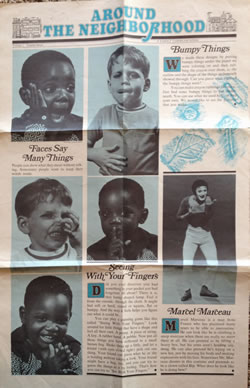
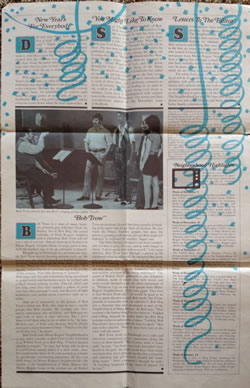
[click images for larger view]
Articles included:
- Faces Say Many Things
- Bumpy Things
- Seeing With Your Fingers
- Marcel Marceau
- New Year's For Everybody
- You Might Like to Know
- Letters to the Editor
- Bob Trow
- Neighborhood Highlights
Articles
People can show what they mean without talking. Sometimes people want to keep their words inside.
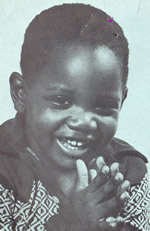
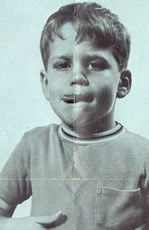
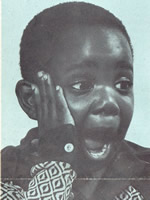
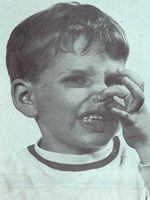
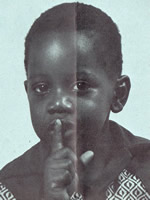
We made these designs by putting bumpy things under the paper we were coloring on and then rubbing the crayon over them, so the outline and the shape of the things underneath showed through. Can you guess what some of the bumpy things were?
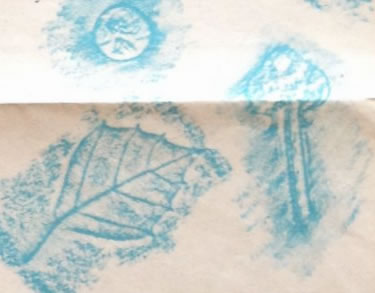
You can make crayon rubbings like these. Just find some bumpy things to put underneath. You can use what we used here or find your own. We would like to see the pictures that you make.
Did you ever discover you had something in your pocket you had forgotten all about? There it is, that funny shaped lump. Feel it from the outside, through the cloth. It might feel soft or hard, round or square, flat or bumpy. And the way it feels helps you figure out what it could be.
You can play a guessing game like this called "Seeing With Your Fingers." Look around for little things that have a shape and feel all their own. A penny. A piece of string. A key. A rubber band. A pebble. Now put all those things you have collected in a small brown bag. Shake them up a little, and let a friend (with eyes closed tight) pick out one thing. Your friend can guess what he or she is holding without taking a look. Your friend might have a bag, too, and you can try to guess the things in it by feeling. That's how you can try to "See With Your Fingers."
Marcel Marceau is a man from France who has practiced many years to be able to pantomime. He can look like he is climbing a steep staircase when there are really no stairs there at all. He can pretend to be lifting a heavy box, but his arms aren't holding anything. He can also pretend he's trying on a new hat, just by moving his body and making expressions with his face. Sometimes Mr. Marceau dresses in this costume and pretends to be a clown called Bip. What does he look like he is doing here?
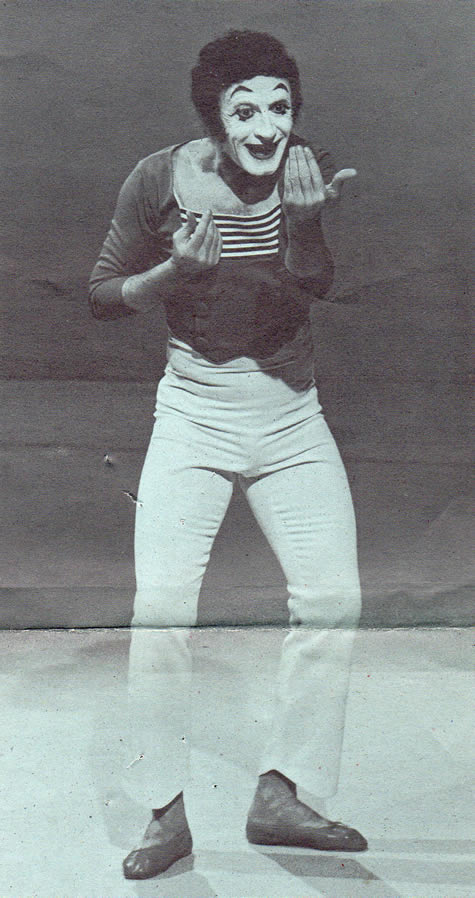
Did you ever think how New Year's Eve is kids' fun planned "for adults only?" Think of all those decorations: streamers and crepe paper and confetti, hats and horns and noisemakers. Just like a great big birthday party. It's only natural that the children may feel excluded when they hear about the party taking place at midnight, long after they've gone to bed. Often children say, "Be sure to wake me up at midnight so I can celebrate New Year's too."
Why not give the children in your family a New Year's all their own, an early celebration with all the trimmings that may help them to see that New Year's is for everyone. Declare six, seven, or eight o'clock the magic hour. No noisemakers or confetti until then, but party games or songs and, of course, refreshments. Keep a big clock right beside you, and let everyone count down when the hour approaches.
Sey Chassler, editor-in-chief of Redbook magazine, felt a special love for the storybook he and his twin sister shared at the age of six, and he kept it safe as he grew older. When he recently met Fred Rogers, he brought the book out to show. The two men agreed the stories deserved to be published again today. From among the many old favorites they chose "Mother Hubbard and Her Wonderful Dog," a longer version than we are used to hearing, "Dame Wiggins of Lee, and Her Seven Wonderful Cats," and "The Story of the Three Bears," in which not youthful Goldilocks but rather an impudent old lady intrudes upon the little house in the woods. Fred Rogers wrote short introductions to each of these tales, and a prefatory comment to them all relating the joys of reading as an adult to the comfort of hearing stories being read aloud as children. Each story is accompanied with original turn-of-the-century illustrations. The stories and their introductions appear in the December issue of Redbook.
Several parents have written to us expressing disappointments in Around the Neighborhood. They and their children had expected it to be a publication for children. The articles, their subjects and the way they were written, seemed in the first six issues much too old for the children who looked forward with excitement to receiving a newspaper from Mister Rogers' Neighborhood. We have a feeling that although a small number of parents have actually written with these feelings, there may be more of you who share them. With that in mind, we are trying to learn from you and change.
The whole front page of Around the Neighborhood will be for children from now on...with more pictures, with print that is easier to read, and with stories and captions adults can read to children. But we want to keep communicating with you, the adults, so we are going to save space on the back of Around the Neighborhood for you. We hope this change will please you and your children, and make this paper a better family communication.
Bob Trow is a man of many faces: the gnomish grin of Robert Troll, the flouncy fur of Bob Dog, the casual welcome of Fred Rogers' neighbor with a workshop. Bob Trow will tell you (only if you ask) that all those parts he plays on Mister Rogers' Neighborhood are truly parts of him. And the hardest one to be on television is himself.
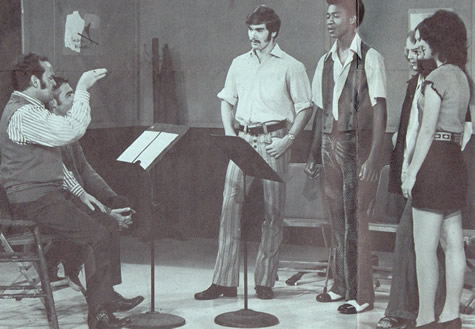
Brought up in Pittsburgh in a no-nonsense family, Bob Trow started drawing pictures early on. He would pass the time in church on Sunday mornings drawing cartoon faces on the back pages of hymn books. "But I decided I'd better stop one day," Bob recalls, "when I heard the preacher say in the middle of his sermon, 'Now take drawing in hymnals...'" Bob sang a lot, too, and remembers being introduced to gospel music and harmonies while he worked with a black friend painting houses. The job didn't last too long, once they had toppled a gallon of paint over into their customer's oven, but the love of tight harmonies and soulful music continues right up to today.
And on to tomorrow, in the person of Bob Trow's oldest son, Rob, who sings in two a capella groups that Bob coaches. His younger son, Eric, enjoys cartooning and sketching, and Bob encourages both of them in their interests. "But I don't want to tell them what to do or what to be," he says. He feels sure of both sons, because they've always managed to keep themselves busy. "They're a lot like me in that way," he muses.
Bob Trow visits Mister Rogers' Neighborhood a couple times a month, as Bob Trow in his workshop or as Robert Troll or as Bob Dog. "I find it hardest playing it straight," he says, but being able to do it in a workshop setting makes it a little easier, since he's comfortable there. In his own workshop at home he spends time constructing miniatures. He has even built things for Mister Rogers' Neighborhood -- the models of the Neighborhood of Make-Believe that Mister Rogers keeps in his kitchen are all Robert Trow productions. It took him three months of working in his spare time to get them all finished. He also made the Prince Tuesday puppet, but since the prince is growing each season, the one Bob made will someday be replaced by another, bigger one.
The Make Believe characters are more comfortable for him to play, he says, adding with tongue in cheek, "I don't speak very well as myself." Like many children, Bob Trow went through a period in his childhood when he stuttered. He mastered that problem as he grew older, and recalls it in the gibberish Robert Troll speaks. When children hear him talking in incomprehensible syllables, they see an adult figure who shares with them the frustrating but often unavoidable situation of not being understood. The sound of Robert Troll's gibberish is also delightful to children , many of whom play with words and word sounds themselves for the sheer enjoyment of it. "Whenever I go on tour with people from Mister Rogers' Neighborhood, all the kids giggle. They love to hear Robert Troll talk." (It would be great to be able to quote the next remark Bob made, but it's impossible to transcribe with our alphabet!) Bob Dog was a character that later developed as part of the Neighborhood of Make-Believe. As Bob says, "That costume's the hottest thing I've ever been in." Padded and stifling, beneath the studio lights the Bob Dog costume is almost unbearable at times. "Luckily, Bob Dog doesn't have many difficult lines to speak," Bob says with a chuckle. "What he does have sort of dissolve with the sweat."
Bob Trow works in Pittsburgh as a radio and television commercial writer, sometimes doing the voices in them himself. "My favorite work is comic stuff," he says. "I go back, way back, into what's happened in the past. An event could have been tragic way back then, but it gives me an idea for a situation and somehow that gets twisted around into something funny." After a moment's thought he adds: "If anything happened to my sense of humor, I'd be lost."
Note: If you miss a program that you or your child is particularly interested in, check with your local station to see when it will be repeated. Give them the program number.
Week of December 3:
Mister Rogers shows a film of the Racoon Ballet, Monday (#401) and talks about the fears many children have in the nighttime. Daniel introduces his imaginary friend to the Neighborhood of Make-Believe, and Wednesday (#403) Malcolm Apricot Dinko joins the others working on Donkey Hodie's potato patch. A Neighbor arrives on Thursday (#404) by the name of Harriett Elizabeth Cow. Friday (#405) Ezra Jack Keats shows his book, Pet Show.
Week of December 10:
Lady Elaine is disturbed by the arrival of Harriett Elizabeth Cow, until she learns on Tuesday (#407) that no matter how much the Neighbors of Make-Believe like the newcomer, they still like Lady Elaine for who she is. Thursday and Friday (#409 & #410) everyone in Mister Rogers' Neighborhood are getting ready for the Variety Show in Betty's Little Theater. Mister Rogers also spends time Thursday (#409) showing about Braille.
Week of December 17:
The Variety Show takes place Monday (#411). A strange purple visitor appears in the Neighborhood of Make-Believe Tuesday (#412) and is joined by two more purple travelers named Paul and Pauline Wednesday (#413). The Neighbors of Make-Believe are curious to hear about the way people and pandas live on Planet Purple.
Week of December 24:
The Browns are getting ready to give a puppet show of The Three Little Pigs. Monday (#416) they show Mister Rogers how the houses of twigs and straw are built so they fall down when the wolf puppet seems to blow on them. The performance is given Wednesday (#418). A very special visitor comes to Mister Rogers' Neighborhood Friday (#420): Marcel Marceau, the pantomime.
Week of December 31:
Mister Rogers talks about natural fears and natural causes of thunder and lightning Thursday (#424). When Daniel starts talking about his birthday, Panda realizes he has no birthday. Daniel shares his, and there is a party for them both on Friday. Mister Rogers has an astronaut visiting Friday (#425): Al Worden, bringing a rock from the moon.
Week of January 7:
Tuesday (#427) Mister Rogers goes to visit the dentist and talks about the waiting room, teeth-cleaning, and brushing teeth. Tuesday, Wednesday, and Thursday (#427, 428 and 429) John Reardon of the Metropolitan Opera Company comes to Make Believe and begins to work with everyone on the new opera, and Friday (#430), "Potato Bugs and Cows," an opera about a discontented cow on a farm, is performed.
Week of January 14:
Queen Sara is sick, as King Friday announces on Wednesday (#433). Since Daniel is afraid she will never return, Dr. Bill assures him she will soon be better. Thursday (#434) Mister Rogers shows a film of himself going to Esther Farnas, M.D. for an injection.
Credits
Around the Neighborhood and the materials that accompany it are published ten times a year by Family Communications Inc., a not-for-profit Pennsylvania corporation. Mr. Rogers' Neighborhood is funded by grants from the Sears Foundation and the Corporation for Public Broadcasting.
Around the Neighborhood is created for FCI by Media Projects Incorporated of New York. Subscription printing and distribution accomplished by Multiscope, Inc., Pittsburgh, Pennsylvania.
Executive Editor: Sara Stein
Editor: Susan Tyler Hitchcock
Editorial Staff: Hedda Sharapan, Mary Gale Moyes
Production Supervisor: Jim Macandell
Graphic Designer: Tobias O'Mara
© 1973, Family Communications Inc.
